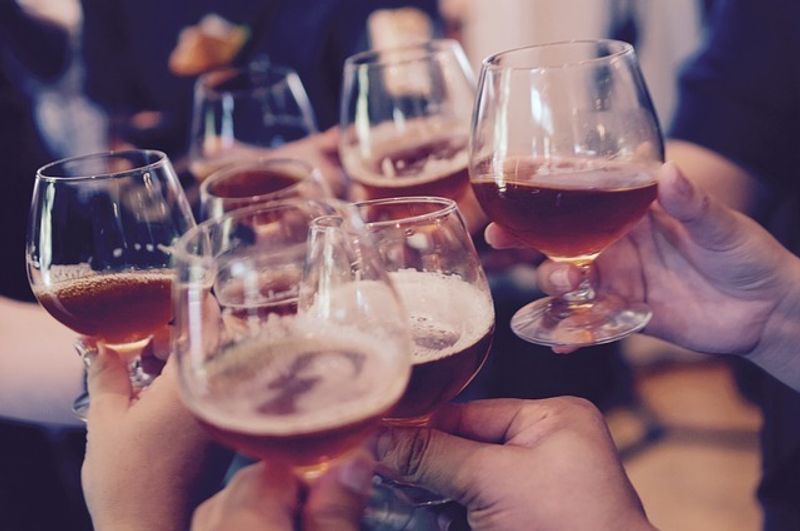
Nomikai in Japan is an art to be mastered if you want to survive in the corporate world
About the meaning: Nomikai (written 飲み会 can be translated as "drinking session" from 飲む: drink and 会:meeting, session, gathering, ...)
Mostly after work, your colleagues or boss might tap your shoulder and invite you to have some drinks with them.
There are plenty of occasions and I will describe few of them.
The official Nomikai:
Shinnenkai (新年会 or New year's party)
It brings generally all the office or depending on your size can be arranged by departments/divisions. Also you might have some shinnnenkai with your distributors/customers. All in one you might have to join several of them in January.
Bounenkai ( 忘年会 or End of the year's party)
This is mainly to celebrate the end of the year. Even if Japanese companies have their fiscal year finishing generally end of March, it is generally held in December.
This is the occasion to forget everything, including ranking relationship within the company. Be prepared to see thousands of salarymen in the streets, often inebriated to an extent which is unbelievable for peoples coming from abroad.
Reservations are often done very early as most of the places will be crowded with parties.
The more regular Nomikai:
Hanseikai (反省会 or evaluation meeting, it is also translated by ALC as "post-mortem meeting"...)
This is generally a drinking session after a customer meeting, or some event which not have gone as you expected to reflect the root causes, to think about what could be improved and so on...
Kangeikai (歓迎会 or welcome party)
Generally a new employee joins the company you have some dinner or drinking session with them to get to know him/her and to let him/her get to know the other employees.
Soubetsukai (送別会 or farewell party)
This is when an employee leaves the company. It can be for good or bad reasons. Depending on the cases you might have a general company soubetsukai with all the employees and many smaller sessions with his/her department (in case they want to complain about the boss...)
On top of that there are plenty of occasions to have a nomikai, here are some more:
Finishing a project -> let's have a Nomikai
3 days exhibition in Big sight -> let's drink all together the last day
Want to complain about the boss -> another Nomikai session with your colleagues
Lost a customer? -> another Nomikai with your boss which might turn into a Hanseikai
Now how to deal about some many drinking sessions and with your health?
Situation has evolved in Japan compared to the eighties or even the nineties.
Before you used to have the following schedule:
- Nomikai with let's say 15 members (from 18:00 to 20:00)
- Then nijikai (二次会 or second party) maybe in a karaoke with less peoples (around 10 members) as some are leaving very far
- Then finally a sanjikai (三次会 or third party), maybe in a bar with only the core members (4 or 5 of them)
At this stage, either you could not find a train and then decided to party more (some peoples applied for "Sick-ill" as they say the next day and did not come office) or they were coming back by taxi.
Recently, most of companies at least in the industries I have been working in are finishing after 1 or 2 parties and many companies will accept that the employees want to come back just after the first party.




6 Comments
KamaT
on Feb 9
This was interesting. I wonder how effective these hanseikai are if everyone is drinking?!
DirectionJapan
on Feb 10
This is an interesting point! Indeed, in Japan it is often said that "The process is more important than the result". Which would lead naturally to the next hanseikai...
KamaT
on Feb 15
@DirectionJapan Yeah, and the one after that! Do you ever get frustrated with the decision making process over in Japan? Tends to be quite lengthy is my experience. Maybe it's different in gaishikei.
DirectionJapan
on Feb 15
@Tomuu Hello Thank you for your comment. It is true that you can build a lot of frustration with the decision making process in Japan. This is true even in Gaishikei. But you have two types. Old Gaishikei (established for over decades in Japan) tend to become real Japanese companies. (just pick-up the one present in Japan already 30 years ago and you will find that they are doing everything like in a pure Japanese company). New entities might be different. Also it depends on the top, if you have a Japanese person or a Foreigner. But still lenghty decision process can bring frustration to everyone on board. You have to adapt to it, if not you will become a victim and get all the stress on you. Recently in my company I refuse lengthy meetings and have 15 minutes one-to-one meetings (kind of an elevator speech) Bring me your issue-Bring me your proposal- and let's decide Together. You might be interested to see which kind of peoples you meet also in a Gaishikei in my blog : http://directionjapan.com/mythology-of-a-gaishikei/ It's kind of RPG style description of all peoples you might meet.
KamaT
on Feb 17
@DirectionJapan Was it easy to refuse to have length meetings? The thing is, in my experience, a lot of Japanese colleagues tend to tell me that they don't like or understand the long processes they have. Wow! Some strong words at the end of your post there ... "Please don't bring gaijin. I ..... ".
DirectionJapan
on Feb 18
@Tomuu Well, some peoples do really like to have "meetings", so it depends on the person. But generally it was well accepted. I will add a post on "Meetings in Japan" in the next few minutes...